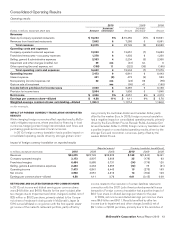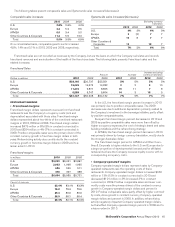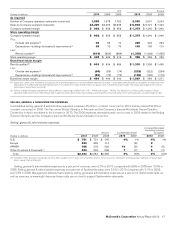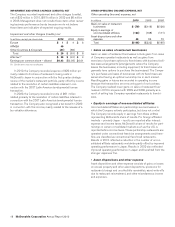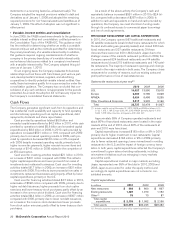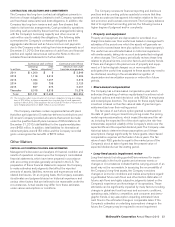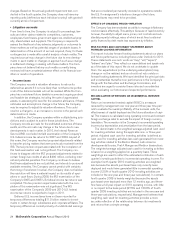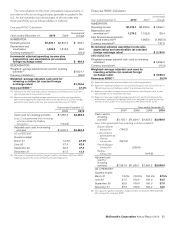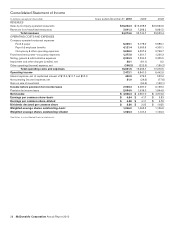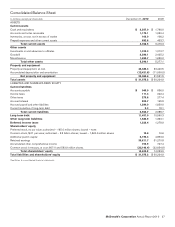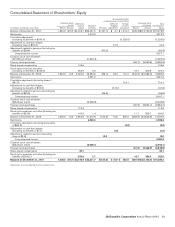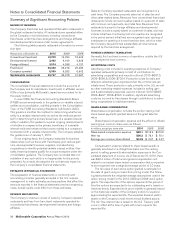McDonalds 2010 Annual Report Download - page 24
Download and view the complete annual report
Please find page 24 of the 2010 McDonalds annual report below. You can navigate through the pages in the report by either clicking on the pages listed below, or by using the keyword search tool below to find specific information within the annual report.
a change in credit ratings or a material adverse change in the
Company’s business. Under existing authorization from the
Company’s Board of Directors, at December 31, 2010, the
Company has $3 billion of authority remaining to borrow funds,
including through (i) public or private offering of debt securities;
(ii) direct borrowing from banks or other financial institutions; and
(iii) other forms of indebtedness. In addition to registered debt
securities on a U.S. shelf registration statement and a Global
Medium-Term Notes program, the Company has $1.3 billion
available under committed line of credit agreements as well as
authority to issue commercial paper in the U.S. and Global market
(see Debt financing note to the consolidated financial
statements). Debt maturing in 2011 is approximately $601 mil-
lion of long-term corporate debt. In 2011, the Company expects
to issue commercial paper and long-term debt to refinance this
maturing debt. The Company also has $595 million of foreign
currency bank line borrowings outstanding at year-end 2010.
The Company uses major capital markets, bank financings
and derivatives to meet its financing requirements and reduce
interest expense. The Company manages its debt portfolio in
response to changes in interest rates and foreign currency rates
by periodically retiring, redeeming and repurchasing debt, termi-
nating exchange agreements and using derivatives. The
Company does not use derivatives with a level of complexity or
with a risk higher than the exposures to be hedged and does not
hold or issue derivatives for trading purposes. All exchange
agreements are over-the-counter instruments.
In managing the impact of interest rate changes and foreign
currency fluctuations, the Company uses interest rate exchange
agreements and finances in the currencies in which assets are
denominated. The Company uses foreign currency debt and
derivatives to hedge the foreign currency risk associated with
certain royalties, intercompany financings and long-term invest-
ments in foreign subsidiaries and affiliates. This reduces the
impact of fluctuating foreign currencies on cash flows and
shareholders’ equity. Total foreign currency-denominated debt
was $4.7 billion and $4.5 billion for the years ended
December 31, 2010 and 2009, respectively. In addition, where
practical, the Company’s restaurants purchase goods and serv-
ices in local currencies resulting in natural hedges. See Summary
of significant accounting policies note to the consolidated finan-
cial statements related to financial instruments and hedging
activities for additional information regarding the accounting
impact and use of derivatives.
The Company does not have significant exposure to any
individual counterparty and has master agreements that contain
netting arrangements. Certain of these agreements also require
each party to post collateral if credit ratings fall below, or
aggregate exposures exceed, certain contractual limits. At
December 31, 2010, neither the Company nor its counterparties
were required to post collateral on any derivative position, other
than on hedges of certain of the Company’s supplemental benefit
plan liabilities where our counterparty was required to post
collateral on its liability position.
The Company’s net asset exposure is diversified among a
broad basket of currencies. The Company’s largest net asset
exposures (defined as foreign currency assets less foreign cur-
rency liabilities) at year end were as follows:
Foreign currency net asset exposures
In millions of U.S. Dollars 2010 2009
Euro $5,465 $5,151
Australian Dollars 2,075 1,460
Canadian Dollars 1,123 981
Russian Ruble 589 501
British Pounds Sterling 547 679
The Company prepared sensitivity analyses of its financial
instruments to determine the impact of hypothetical changes in
interest rates and foreign currency exchange rates on the
Company’s results of operations, cash flows and the fair value of
its financial instruments. The interest rate analysis assumed a one
percentage point adverse change in interest rates on all financial
instruments, but did not consider the effects of the reduced level
of economic activity that could exist in such an environment. The
foreign currency rate analysis assumed that each foreign currency
rate would change by 10% in the same direction relative to the
U.S. Dollar on all financial instruments; however, the analysis did
not include the potential impact on revenues, local currency prices
or the effect of fluctuating currencies on the Company’s antici-
pated foreign currency royalties and other payments received in
the U.S. Based on the results of these analyses of the Company’s
financial instruments, neither a one percentage point adverse
change in interest rates from 2010 levels nor a 10% adverse
change in foreign currency rates from 2010 levels would materi-
ally affect the Company’s results of operations, cash flows or the
fair value of its financial instruments.
22 McDonald’s Corporation Annual Report 2010



